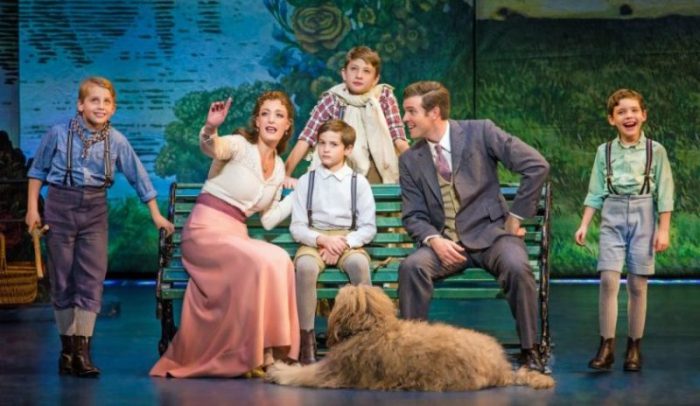
Finding Neverland is one of a large number of spin-offs of J. M. Barrie’s play, Peter Pan. This musical had a year’s run on Broadway due to the popularity of Matthew Morrison in the role of Barrie. Without that appealing star of Glee and The Light in the Piazza, the show drags.
The plot is slight, but director Diane Paulus has created some delightful stage action. The production is adorned with excellent choreography by Mia Michaels, beautiful period costumes by Suttirat Anne Larlarb and fanciful sets by Scott Pask. A vivid special effect with fairy dust brightens the late moments of the show.
Finding Neverland purports to tell us how Barrie created his enduring play. In reality, Barrie based his title character on his older brother, David, who died in an ice-skating accident at the age of thirteen. In this musical, we’re told that Peter Pan is inspired by Peter Llewelyn Davies, one of the four sons of a young widow, Sylvia Llewelyn Davies, whom Barries meets one day at London’s Kensington Gardens. That is a partially true story.
Actually, Barrie became a close friend of the parents and their boys (there were only three sons when Barrie met the family.) They vacationed together for years. Two years after Barrie’s play opened, the father died of cancer, in 1906. Four years later Sylvia died, also of cancer.
One of the boys was killed in battle in World War I. Another died in what many believe was a suicide pact with his male lover. Peter Davies suspected that Barrie had a pedophilial relationship with another one of his brothers, and he wrote: “The whole business, as I look back on it, was almost unbelievably queer and pathetic.” Peter committed suicide in 1960 by jumping in front of a London subway train. Now, all of this would make a good plot for a play.
But let’s get back to the story which this musical chooses to tell. Finding Neverland depicts Barrie as married but childless, while Sylvia is supposedly a widow. Barrie’s wife is depicted as bitchy and unfaithful, so audiences will root for Barrie to leave her and marry the attractive widow, sweetly played and sung by Christine Dwyer.
The character of Captain Hook is shown to be based on Charles Frohman, the producer of Barrie’s plays, here played boldly by John Davidson. (The real producer and theater owner Frohman died when the passenger ship Lusitania was sunk by a German submarine in 1915. Frohman’s live-in companion was theater critic and producer Charles Dillingham.)
Billy Harrigan-Tighe is the touring Barrie. He has a sweet singing voice, and the bland charisma of a local TV weatherman. Playwright James Graham and director Paulus take the spotlight off him and devote most of Act II to the children, who are appealing youngsters.
The re-enactment of opening night is a let down because it lacks the wonderful music by Julie Stein, Moose Charlap, Betty Comden and Adolph Green which everyone loves from the TV production of Peter Pan. This show has a score by British pop writers Gary Barlow and Elliot Kennedy that includes a few catchy tunes plus some cloying numbers for the kids.
Although I normally wouldn’t care about Barrie’s orientation, I find curious (and disturbing because of Peter’s statement) these lines in Barrie’s play The Little White Bird, which contains his first references to Peter Pan. Barrie wrote: “He passed the night with me….I took [his boots] off with all the coolness of an old hand, and then I placed him on my knee, and removed his blouse. This was a delightful experience, but I think I remained wonderfully calm until I came somewhat too suddenly to his little braces, which agitated me profoundly…”